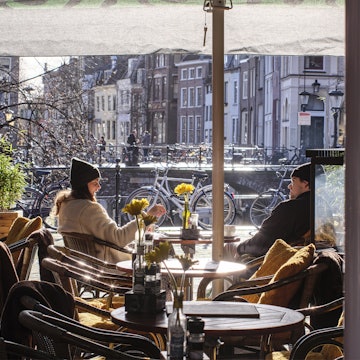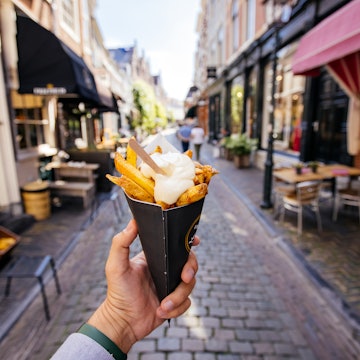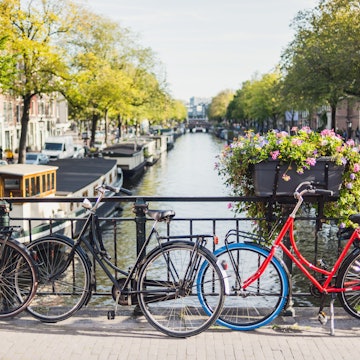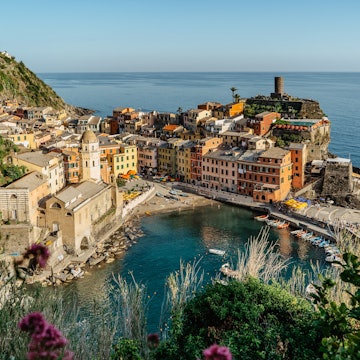

Dutch treats range from savory to sweet like these traditional donuts © Ira Heuvelman-Dobrolyubova / Getty Images
Hearty meat, mashed vegetables and huge wheels of cheese are just the start of the Dutch culinary story. The country has a natural larder of lush fields, pastures, coastline and waterways, and tens of thousands of acres of high-tech greenhouses.
Influences from its European neighbors and a mosaic of cultures – including its complex historical links to merchant trade, imperialism and immigration – plus a focus on sustainability all enrich the Netherland’s diverse food scene.
Ranging from herring and mayo-slathered fries to spicy rijsttafels (Indonesian-inspired small plates) and refined, increasingly plant-based contemporary Dutch cookery, these are the best food experiences in the Netherlands.
Snack your way around the Netherlands’ markets
A great introduction to Dutch flavors is browsing a markt (market). Along with fresh produce and colorful flowers, stalls sell tantalizing sweet treats like warm, gooey stroopwafels (wafers sandwiched with sticky caramel syrup), poffertjes (puffy mini-pancakes dusted with icing sugar). Market stalls are also a good place to trawl for seasonal bakkerij (bakery) favorites like speculaas (spiced cookies) and oliebollen (deep-fried dough balls) popular around Christmas as well as localized regional specialities, and confectionery including the nation’s beloved salty licorice, drop. Savory Dutch snacks (herring, cheese and fries included) also abound.
Where to try it: Open-air markets set up in cities and towns at least once a week. In Rotterdam, the landmark covered Markthal has a heady array of food and drink stalls in a spectacular horseshoe-shaped building.

Dangle haring (herring) by the tail
As a seafaring nation, fish is hugely popular, and none more so than haring (herring). Prized Hollandse Nieuwe, a national and EU-protected traditional speciality, is only caught from May to September. The traditional way to eat the raw, brine-cured delicacy it is to pinch the tail between your thumb and forefinger, tip your head back and dangle it from above. Alternatively you can have it chopped in small pieces with uitjes (diced onions) and zuur (sweet pickles) and eat it using a toothpick, or in a fluffy white roll as a broodje haring (herring sandwich).
Fried fish dishes you’ll see often include kibbeling (battered small pieces of whitefish like cod or hake, accompanied by garlic or tartar sauce) and lekkerbek (similar but larger filets, ie Dutch fish and chips).
Where to try it: The best herring is prepared freshly at haringhuizen (herring stands), haringhandels (herring carts) and vishandels (fishmongers), often emblazoned with red-white-and-blue Dutch flags, which are found all over the Netherlands (Stubbe's Haring, on Amsterdam’s Singel canal is an institution). At the coast near Den Haag, Scheveningen’s Vlaggetjesdag (Flag Day) celebrations commemorate the decorating of fishing boats in the harbor.
Fork into a coneful of Vlaamse frites
Crispy, fluffy Vlaamse frites (“Flemish fries”; aka friet, frieten or patat – the name is the subject of spirited local debate) are thickly cut from whole potatoes, twice fried and slathered with a choice of sauces (from classic mayonnaise to green pepper, vinegary piccalilly, curry or spicy sambal; oorlog is a classic Dutch combination with mayo, peanut satay and onions), typically served in paper cones with a small fork. Everyone in the Netherlands has firm opinions on where to get the best.
Where to try it: You’ll find fries everywhere from street markets, freestanding kiosks and hole-in-the-wall takeaways to sleek, contemporary boutiques and specialist sit-down restaurants. Top picks for an on-the-go fix include Haarlem’s new-generation Friethoes, and Amsterdam’s old-school Vleminckx, frying since 1957.

Devour Dutch kaas (cheese)
With its grazing pastures and historic trading towns, the Netherlands is synonymous with kaas (cheese). The most prevalent is rich, creamy Gouda, typically encased in yellow paraffin wax and classified from jong (young) to belegen (mature) and oud (aged), such as crumbly, crystalized Oud Amsterdammer. Similar in style but milder is semi-hard Edam, usually covered in red wax. Other varieties include Leidse (Leyden), speckled with cumin seeds, and Maasdammer, with Emmental-style holes.
As well as cow’s milk kaas, look for geitenkaas (goat’s cheese) and schapenkaas (sheep’s cheese). Boerenkaas (farmhouse cheese) is made with raw, unpasteurized milk.
Where to try it: The charming towns of Gouda, Edam and Alkmaar have museums and lively historic cheese markets entertaining the crowds during the warmer months. Many cheese-producing farms across the country open to visitors, such as Kaasboerderij Wezenspyk on the island of Texel, and Booij Kaasmakers in Streefkerk, near Rotterdam. Vendors at market stalls and stacked-to-the-rafters shops throughout the Netherlands often let you sample before buying.

Dig into Dutch pannenkoeken (pancakes)
In the Netherlands, pannenkoeken (pancakes) can constitute an entire meal, with numerous places specializing in giant, cartwheel-style creations of thin, crepe-style pancakes with savory toppings (such as cheese and mushrooms) as well as sweet (like spiced pears).
Where to try it: Pancakes virtually cover the table at Leiden’s ‘t Pannenkoekenhuysje Oudt Leyden. On Nijmegen’s outskirts, De Duivelsberg has an enchanting setting on the edge of the forest.
Savor refined contemporary Dutch cookery
Innovative Dutch chefs are reimaging old, traditionally heavy recipes and giving them a lighter, contemporary spin, as well as melding concepts and techniques from around the globe with locally sourced produce. In tune with the Dutch commitment to creating a fully circular economy by 2050, sustainability is at the heart of contemporary Dutch cooking, with a focus on organic, farm-to-fork dining, and a growing number of cutting-edge restaurants concentrating exclusively on plant-based cooking.
Where to try it: Contemporary showcases include Het Arsenaal in an old monastery in Hanseatic Doesburg (with its own brewery), intimate Tres in Rotterdam, factory-set Novo and inspired Beluga Loves You in Maastricht, and hyperlocal Triptyque in Den Haag and Neder in Alkmaar, just for starters. At Amsterdam’s De Kas, dine on ingredients grown in its surrounding century-old glasshouses and gardens. Utrecht’s Kasvio (whose mantra is “cooking as storytelling”), and Nijmegen’s double-Michelin-starred De Nieuwe Winkel (“botanical gastronomy”) are entirely vegan.
Dine on Dutch comfort dishes
Chilly winter weather is held at bay by warming Dutch comfort dishes like stamppot (potatoes mashed with vegetables and topped with sausages), hutspot (“hotchpotch” of potatoes, carrots, onions and braised meat), erwtensoep (split-pea soup with bacon or smoked sausage and thick rye bread) and boerenkool met worst (mashed potatoes with kale and smoked sausage). Desserts include appeltaart (tall apple pie made from brown-sugar shortcrust pastry filled with cinnamon apples), spekkoek (layered spice cake), and hangop (thick, creamy strained yoghurt with fruit compote).
Where to try it: Wonderful Dutch classics are dished up at Amsterdam stalwart Hap Hmm. At Spijshuis de Dis in Delft, end your meal with semolina pudding with brandied raisins or apricots, served in a wooden clog.
Vegetarians and vegans
The Netherlands is a pioneer of plant-based cuisine, and a quarter of main meals eaten in the country are vegetarian. Vegetarians and vegans will find a multitude of options at all price points, from market-stall snacks through to high-end gourmet experiences.
Numerous cafes and restaurants are exclusively vegetarian or completely vegan, and those that aren’t usually have vegetarian (and often vegan) dishes or set menus available.

Share a rijsttafel Indonesian banquet
Spices are prevalent in the Netherlands, a legacy of the Dutch colonization of Indonesia. A dining highlight is a rijsttafel (“rice table”), an elaborate Indonesian feast of a dozen or so tiny dishes such as pork satay, braised beef and ribs, served with white rice. Other popular dishes at Indonesian restaurants include nasi goreng (spiced fried rice with onion, pork and shrimp and spices, topped with egg) and bami goreng (with noodles rather than rice). Mild is usually the default setting to cater to European palates but restaurants will fire up the heat if you ask (you’ve been warned!).
Where to try it: Haarlem’s Café Samabe, Utrecht’s Djakarta and Amsterdam’s Restaurant Blauw are excellent places for Indonesian cuisine.
Scoop up Surinamese roti
Caribbean-style Surinamese cuisine, from the tropical South American country of Suriname, formerly colonized by the Dutch, prominently features chicken, lamb or beef curries; pom is a festive chicken and root-vegetable casserole. Roti, soft savory pancake-style flatbread wraps with curried meat or vegetables such as garter beans, are filling and delicious.
Where to try it: Amsterdam’s Tokoman makes outstanding roti and Surinamese sandwiches, washed down with cold coconut water. In Rotterdam, try Surinamese dishes at Brasserie Timmerhuis, and in ‘s-Hertogenbosch (Den Bosch), head for the cozy warmth of Tante Wonnie, cooking family recipes to a soundtrack of Surinamese kaseko.

Soak up frothy beers with borrelhapjes (bar snacks)
Bier (beer) is more popular than ever in the Netherlands, from icons like 1615-founded Grolsch and 1845-founded Heineken to abbey-made Trappist beers and an explosion of craft brewers, with more than 900 active breweries around the country today.
Borrel (“drinks”) is the perfect opportunity to raise a glass and bite into quintessentially Dutch borrelhapjes (bar snacks) such as kroketten (croquettes) including bitterballen (small, round meat ragout varieties) served with mustard, and kaasloempias (Indonesian spring rolls filled with melted Gouda).
Where to try it: The Netherlands overflows with bars, tap rooms and cafés (pubs) specializing in beer, such as Groningen favorite De Pintelier. Amsterdam’s historic, dark-timbered bruin cafés (brown cafés) like canalside Café Papeneiland are enchanting places to experience Dutch gezelligheid (conviviality and coziness).
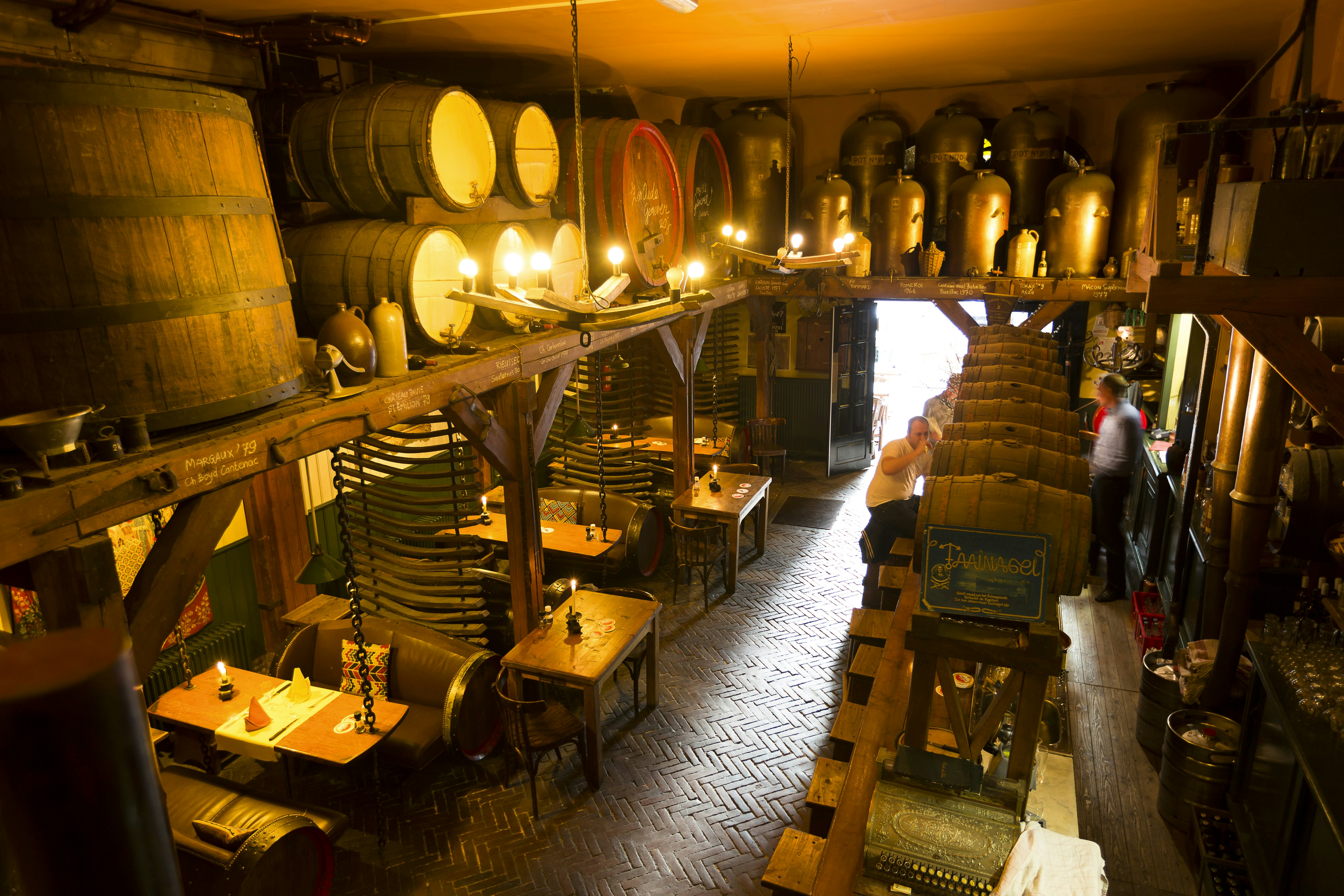
Sip jenever (Dutch gin) at a tasting room
Made from juniper berries, jenever (Dutch gin; sometimes spelt genever) originated in the Netherlands around the 16th century for medicinal purposes. Jonge (young) jenever is smoother; barrel-aged oude (old) jenever has a much stronger flavor. It’s traditionally served chilled in a brimming, tulip-shaped shot glass and drunk by bowing low over the bar, with your hands behind your back, before taking a deep sip.
Where to try it: A historic proeflokaal (tasting room) such as Amsterdam’s De Drie Fleschjes or Wynand Fockink makes an atmospheric setting for a tipple, while in the capital’s Flevopark, try small-batch jenevers, liqueurs, herbal bitters and fruit distillates at Distilleerderij ’t Nieuwe Diep, in a magical woodland setting. In Doredrecht, Rutte is a history-steeped distillery, as is Nolet, powered by a wind turbine in a neo-traditional windmill in the “Dutch Distillers District” of Schiedam.








